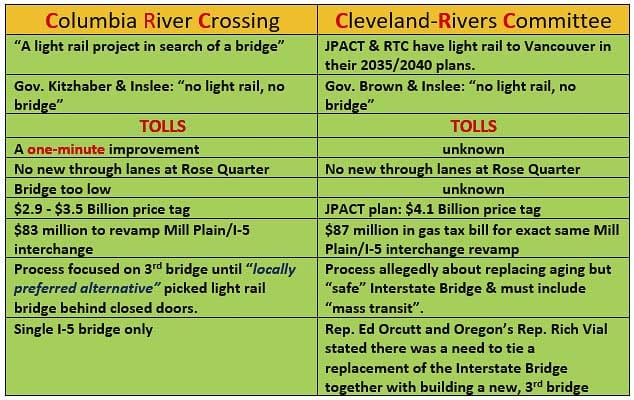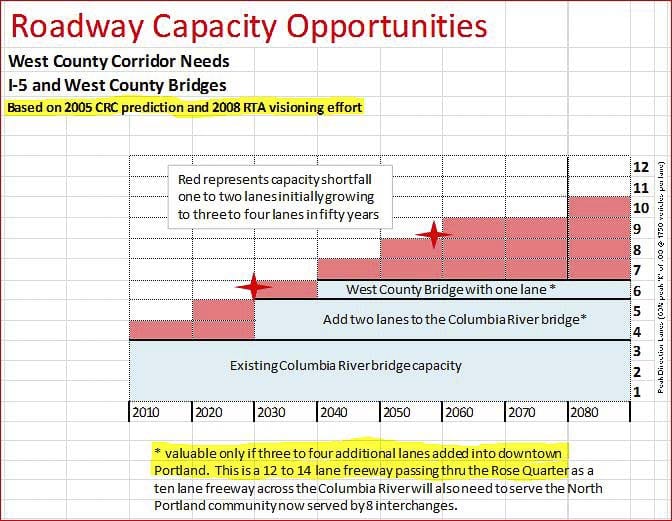Camas resident John Ley offers his latest thoughts on area’s transportation issues

John Ley
For ClarkCountyToday.com
VANCOUVER — The Bi-state Bridge Committee was created by the Washington legislature. Their first meeting was a year ago, but no Oregon representatives attended. The first meeting with Oregon leaders present was the Dec. 11 meeting.
This committee needs to answer one critical question. Is this simply a resurrection of the flawed Columbia River Crossing (CRC) and it’s “light rail project in search of a bridge?” Southwest Washington legislators said this was about “process” and there was “no specific project.” Sen. Ann Rivers said this wasn’t the CRC.
As ClarkCountyToday.com reported: “Sen. Rivers wrapped up with a few comments for the gathered crowd, many of whom she said had sounded alarm bells that “the CRC is back! The CRC is back!”
“I hope that you will sound the alarm that you were wrong,” said Rivers. “I hope you will go to your blogs and say, ‘wow, they don’t even have a process yet. Maybe I should reserve judgement and see what they come up with.’”
But Oregon legislators at the meeting said nothing regarding light rail being included or excluded. Oregon Sen. Cliff Bentz stated there was no other way to pay for a project, other than tolling.
Several of the Southwest Washington legislators said this was about “a new process.” Is it? What’s in the public record?
Oregon Gov. Kate Brown said “no light rail, no bridge” during her re-election campaign. Gov. Jay Inslee just remarked: “light rail must be included to get federal funding.” This was part of his budget request, setting aside $17.5 million to fund a bridge replacement project office for two years.
Light rail is not “required” in order to get federal funding. The CRC finance plan included $400 million federal dollars, not tied to transit. Additional federal “transit” dollars could have been obtained for Bus Rapid Transit over the bridge.
Portland Metro’s JPACT 2040 transportation plan spends $4.1 billion for a bridge and light rail transit into Vancouver. Our own RTC’s 2035 transportation plan includes a new bridge and light rail into Vancouver.
What’s not in either state’s public plans? A third bridge across the Columbia River and a new transportation corridor. That’s what’s truly needed. Especially since Oregon refuses to add new through lanes to I-5 at the Rose Quarter.
Here’s a comparison of the CRC and the current Bi-State Bridge Replacement Committee led by Senators Annette Cleveland and Ann Rivers.

At the Bi-state Bridge Replacement Committee hearing, both Rep. Ed Orcutt and Oregon’s Rep. Rich Vial stated there was a need to tie a replacement of the Interstate Bridge with building a new third bridge across the Columbia River. That was the one hint that this “could” be about additional crossings and addressing the need to add vehicle capacity.
Rep. Vial stated: “I ran for the legislature originally because our transportation challenges particularly in Washington County have begun to become critical.” He later added: “it’s not solely the I-5 bridge. There is a westside north-south solution that has been put off for roughly 38 years in Oregon.”
Rep. Orcutt commented: “I think what we need to be looking at is a replacement of the I-5 crossing and looking at additional crossings. I think we need to be working on it as a package. I don’t think we should leave this process without a plan for additional crossings.” He later added: “The math says that there aren’t enough crossings; there aren’t enough lanes.”
The sentiments of Representatives Vial and Orcutt were echoed by John Charles of the Cascade Policy Institute, during citizen comments.
“I agree that the current I-5 bridge is perhaps functionally obsolete, but I don’t think replacing it or rehabbing it is a huge priority now. It is functional. I think it needs be part of a package deal. I simply reiterate the comments Representative Ed Orcutt made and Representative Rich Vial — you need more capacity. I would bump the I-5 replacement to maybe something you do after 2030 or 2035. No bridges are going to fall down.
“You absolutely need a third, fourth, and fifth bridge. You should think bigger. The same reason that we have about a dozen bridges over the Willamette River in downtown Portland. The St John’s bridge is not the same as a Sellwood or the Markham or the Fremont or the Hawthorne (bridges). They all serve different travel markets and they’re all really important.”
Transportation architect Kevin Peterson scrutinized all the traffic projection numbers from the CRC. He informed us an Interstate Bridge would need six lanes in each direction, by 2030. He told us in 2060, an Interstate Bridge would require nine lanes in each direction.
Additionally, Peterson reported the new lanes across the Columbia River are “valuable only if three to four lanes are added into downtown Portland. This is a 12-14 lane freeway passing thru the Rose Quarter” by 2060.

Knowing Oregon’s reluctance to expand the Rose Quarter, Peterson emphasizes the need for two new transportation corridors. One is needed west of I-5 and the other east of I-205. We saw an immediate 18 percent reduction of I-5 bridge traffic the year after I-205 opened. That’s real congestion relief.
ODOT reports the Rose Quarter has the highest accident rate of any road in Oregon and is the No. 2 bottleneck in the region. That bottleneck begins at Rosa Parks Way and continues south through the Rose Quarter. It does not include the Interstate Bridge.
Citizen Steve Wallace told the committee: “we need lanes, not trains.” He is exactly right — mass transit won’t solve the traffic congestion problems.
There is minimal demand for mass transit between Clark County and Portland. C-TRAN has seven express bus routes traveling both I-5 and I-205. In 2017, only 1,437 people used C-TRAN’s express buses on an average day. Furthermore, light rail on I-5 would simply replace existing transit service for some of these people. Yet it would take them longer to get to downtown Portland, compared to present bus service.
The citizens of Clark County have repeatedly said “no” to light rail. It doesn’t solve their transportation needs. WSDOT recently reported there are 310,000 vehicles crossing the Columbia River on an average day. That’s almost three times the 109,000 vehicles using the Interstate Bridge in 1982, when the I-205 bridge and transportation corridor opened.
Clearly, Representatives Orcutt and Vial are right. New bridges and transportation corridors are needed. Will the rest of the elected officials on this committee agree and propose adding a third bridge and increased regional vehicle capacity? Or will they simply focus on replacing the functional Interstate Bridge with a platform for light rail, which both governors demand?




